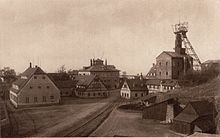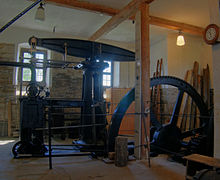Ascension treasure trove
The Himmelfahrt Fundgrube is a former ore mine in Freiberg . The Himmelfahrt Fundgrube has been part of the Erzgebirge Mining Region UNESCO World Heritage Site since 2019 .
The Himmelfahrt Fundgrube with its shafts “Reiche Zeche” and “Alte Elisabeth” is used by the TU Bergakademie Freiberg as a teaching and research mine .
history
The silver mining in Freiberg dates back to the 1168th The pit fields of today's teaching and research mine belong to the central part of the extensive Freiberg mining district and are located in the north-eastern outskirts of the city. The dismantling began here in the Middle Ages in various independent treasure troves . A total of 330 pits named by name can be assigned to the pit field of the later “Himmelfahrt Fundgrube”. As early as 1384, a contract named the two shafts “Vordere Reiche Zeche” and “Hintere Reiche Zeche”, which are among the oldest verifiable mining facilities in Freiberg. In 1511 the “Alte Elisabeth” shaft (north of today's shaft) is mentioned. The “Sanct Elisabeth” mine was one of the most profitable coal mines in Freiberg in the 16th century. It supplied 3.7 tons of silver between 1525 and 1673. The "Abraham" mine produced one ton of silver between 1542 and 1600 and the "Reiche Zeche" between 1564 and 1610 0.7 tons of silver.
The “Himmelfahrt” colliery has been supplying ore since 1716, albeit only to a small extent for the time being (1716–51: 140 kilograms). The pit field of this mine was significantly expanded in the second half of the 18th century by adding the "Abraham Fundgrube" (1752) and the "Alte Elisabeth Fundgrube" (1796). 1828 striking managed rich silver finds the transition crosses various veins or in the newly discovered vein "New Hope Flat". The colliery quickly developed into the most important Freiberg mine and was one of the largest silver mines in Europe. Between 1840 and 1896 the mine had a silver output of 448 tons. The workforce increased from 165 men (1831) to 2,882 men (1856/60). At the end of the 19th century, an average of 1,500 to 2,000 men drove to the “Assumption Treasure Trove”.
The mine field had grown considerably due to the purchase of numerous formerly independent mines, several shafts were newly sunk or modernized through the use of water gaps and steam engines . The daytime facilities (mountain forges, Erzwäschen , stamp mills , cutting banks ) have also been significantly expanded. The main shaft was the "Abraham shaft", whose group of buildings reflects the almost unchanged condition from around 1850 to this day. The second main shaft was the “David shaft”, sunk from 1835 onwards. As early as 1808, the “Alte Elisabeth” shaft was built at its current location. From here also carried propulsion of Rothschönberger Stollns in the non-state portion. In 1841, the lowering of the "Reiche Zeche" shaft began on the mine field of the same name, which was last awarded in 1691 .
With the introduction of the gold standard ("Goldmark") in 1873 the decline of the Freiberg silver mining began. Due to global overproduction, the price of silver halved between 1880 and 1898 and the prices for the by-products lead and zinc also fell massively. The imminent collapse of Freiberg mining was anticipated by the Kingdom of Saxony in 1886 by nationalizing the five most important mines, including the “Assumption Treasure Trove”. The mines were technically modernized under the direction of the senior management of the Royal Ore Mines, but the resulting lower production costs could not keep pace with the fall in silver prices. Due to the inadequate profitability, operations at the “Himmelfahrt Fundgrube” and in the other mines were shut down as planned by 1913.
As early as 1905, the Bergakademie decided to reuse the “Reiche Zeche” and “Alte Elisabeth” pits for scientific purposes. The handover for teaching purposes was delayed by the First World War, but only in 1919. The use comprised apprenticeship training in the areas of machine technology, mining technology and mine cutting in the “Reiche Zeche” shaft and included the preservation and maintenance of the historical facilities around the “Alte Elisabeth” shaft " connected.
In the course of the National Socialist autarky policy , the mining of the Assumption mine was resumed in 1937 by Sachsenz Bergwerks GmbH . The Reiche Zeche shaft was used as a mining and weather shaft . During this time, a depth of 736 m was reached on the “Davidschacht” (1942). After the end of the Second World War , the SAG Wismut carried out explorations for uranium in the area of the mine . The mining and smelting combine "Albert Funk" continued the mining until 1969. In 1953, the “Reiche Zeche” received a new iron headframe , which is today a landmark of Freiberg mining.
Teaching was resumed in July 1945 immediately after the end of the Second World War. Extensive modernization work was carried out for this in the 1980s. Access to historical mines was also made possible. The teaching mine is unique of its kind in Germany, it is the only mine that is operated by a university for the purposes of teaching, research and education. The focus of teaching is on student training in geoscientific and geotechnical courses. The tasks also include the preservation, maintenance and development of historical material (above and below ground). In addition to the two ropeway shafts “Reiche Zeche” and “Alte Elisabeth”, the mine comprises 14 km of secured drives at a depth of up to 230 m.
Mine disaster on February 29, 1880
On February 29, 1880 around 19:00 it came in "Abrahamschacht" the heaviest with eleven dead mine disaster in the traditional Freiberger Revier , as the linkage of driving skills broke. The miners on the approaching night shift fell about 20 meters down with the rubble of the driving art. Eight miners were killed immediately, one died during the rescue and two more the next morning.
Schwarzenberg blower
The Schwarzenberg blower is exhibited at the “Alte Elisabeth” shaft and is considered to be one of the most historically significant works of German mechanical engineering. The fan, designed in a neo-Gothic industrial form, was designed by Christian Friedrich Brendel as a water-wheel-driven blast furnace fan for the Antonshütte . Casting and construction took place in the ironworks owned by Heinrich Ludwig Lattermann in Morgenröthe . The fan generated around 45 cubic meters of wind per minute and weighed around 33 tons without the water wheel. The construction costs amounted to 7,100 thalers .
On July 4, 1831, the blower was put into operation at the Antonshütte . It was in use there until the hut was closed in 1860. In 1862 it was converted to the Halsbrücker Hütte . The blower remained in use here until 1925. A planned installation in the Deutsches Museum in Munich failed due to a lack of space in the museum, so that the blower remained on the Halsbrücker Hütte even after the shutdown. When the blower room was also used in the course of an expansion of the company, the blower was moved to the dump of the "Alte Elisabeth" shaft in 1936. For permanent preservation, a shelter was built for the blower in the immediate vicinity of the existing shaft and machine house.
Himmelfahrt treasure trove as type locality

The Ascension of mine is not only a well-known location for many different and sometimes rare minerals and their varieties , their mine "Reiche Zeche" is also type locality for 1831 by Karl Gustav Adalbert of Weissenbach described as an independent mineral and 1853 by Gustav Adolf Kenngott named Freibergite . A total of 46 types of mineral and 8 varieties have been detected in the pit so far (as of 2013) such as acanthite , chalcopyrite , galena , hematite , pyrite , siderite , stephanite and xanthocone .
Tourist use
The Freiberg Förderverein Himmelfahrt Fundgrube eV has been taking care of the tourist use of the facilities above and below ground since 1992
Guided tours have so far been offered at the following locations:
- Rich colliery
- Old Elisabeth
In spring 2013, the closure of the “Reiche Zeche” visitor mine was announced. Since August 19, 2013, no tourist entrances have been possible to carry out "essential renovation work". The teaching and research mine was also severely restricted.
The tourist business was resumed after the work was completed.
gallery
- Old Elisabeth
Schachtkaue the butter chute 2006
Conveying bin in the laths , hanging bench
Cable drum of the hoisting machine
- Rich colliery
- Abraham Shaft
- underground
Hungarian Hunt
Battery locomotive LEW EL 9
literature
- Ingrid Berg: The stamping wheel at the Thurmhofschacht in Freiberg . In: Petra Binder (ed.): Land calendar book for Saxon Switzerland and the Eastern Ore Mountains 2009 . Schütze-Engler-Weber, Dresden 2008, ISBN 978-3-936203-11-0 , p. 19-21 .
- Reimund Brendler: On the history of the Alte Elisabeth treasure trove . In: TU Bergakademie Freiberg (Hrsg.): 800 years Freiberg mining (= Freiberg research books ). D 70. Verlag für Grundstofftindustrie, Leipzig 1970, ISBN 3-86012-238-X , p. 33-50 (Reprint Freiberg 2004).
- Otto Fritsche: The Schwarzenberg blower. Its preservation on the Alte Elisabeth in Freiberg. A monument to Saxon mechanical engineering . In: Communications from the Saxon Homeland Security Association . tape XXVI , issue 9-12 / 1937. Dresden 1937, p. 255-268 .
- Gerd Grabow : The Schwarzenberg blower. A technical monument on the "Alte Elisabeth" in Freiberg (= Sächsische Heimatblätter . Issue 1/2007). S. 15-19 .
- Jens Kugler : The technical systems of the Abraham art and drift shaft of the Ascension Fund pit (Freiberg). In: Proceedings 17th International Mining & Mining History Workshop Freiberg 2014. ISBN 978-3-86948-364-1 , pp. 91–112.
- Jens Pfeifer: The railways for funding on the Ascension Treasure trove in Freiberg / Saxony. In: Proceedings 17th International Mining & Mining History Workshop Freiberg 2014. ISBN 978-3-86948-364-1 , pp. 113–124.
- Herbert Pforr : The Freiberg silver mine Himmelfahrt-Fundgrube 1168-1969 . Freiberg 1994.
- Axel Rüthrich: On the history of the Ascension, including the Abraham treasure trove in front of Donatstor, from its recording in 1715 to the large ore find of 1828. In: Conference volume 17th International Mining & Mining History Workshop Freiberg 2014. ISBN 978-3-86948-364-1 , p. 83 -90.
- TU Bergakademie Freiberg (Ed.): The Ascension Treasure Trove. A guide through the teaching and visitor mine of the TU Bergakademie Freiberg . Freiberg 1999.
- Dieter Schräber: The Abraham shaft of the Ascension Treasure trove to Freiberg - a large shaft of the Erzgebirge silver mining in the 18th and 19th centuries. In: Mining magazine for raw material extraction, energy, environment. 64 (2013) 10, pp. 448–453 ( [1] PDF, digitized version )
- Otfried Wagenbreth : The Freiberg mining. Technical monuments and history . Ed .: Eberhard Wächtler . 2nd Edition. German publishing house for basic industry, Leipzig 1988, ISBN 3-342-00117-8 .
Web links
- The teaching pit as part of the TU Bergakademie Freiberg
- Visitor information
- Grund and Seiger-Riß from Alt Elisabeth, and part of the Ascension including Abraham Fdgb. (1789)
Individual evidence
- ↑ archiv.sachsen.de ( Memento from December 13, 2013 in the Internet Archive )
- ^ Report in the yearbook for the Saxon mining and metallurgy industry. Year 1882, part 2, pp. (397) / 161.
- ↑ Mindat - description of the location and mineral list for Reiche Zeche Mine, Himmelfahrt Mine, Freiberg, Freiberg District, Erzgebirge, Saxony, Germany (English).
- ↑ Mindat - description of the location and mineral list for Himmelfahrt Mine, Freiberg, Freiberg District, Erzgebirge, Saxony, Germany (English.)
Coordinates: 50 ° 55 ′ 42 ″ N , 13 ° 21 ′ 29 ″ E


































